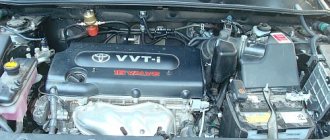Transmission
The all-wheel drive system is reliable. During the operation of the Toyota RAV4, you mainly have to deal with the howling of the driveshaft outboard bearing and the appearance of play in the cardan crosspieces. The cost of a new cross is about 600 rubles, and replacement work costs another 2.5-3 thousand rubles.
The crossover was equipped with two gearboxes: a 5-speed manual and a 4-speed automatic. The clutch of a manual transmission lasts more than 150-200 thousand km. With a mileage of more than 200-250 thousand km, the input shaft bearing may become noisy. On later runs, 5th gear is knocked out.
| Toyota RAV4 (2003-2006) |
“Avtomat” received several chronic diseases. On cars of 2000-2003, after 130-150 thousand km, the microcircuits on the ECU board burn out, which is why shocks (impacts) appear when moving from second to third and after engaging reverse gear. The problem unit is located behind the glove compartment, the cost of re-soldering is about 4-5 thousand rubles. It is better not to delay repairs, as driving with jolts leads to failure of the box itself. A complete repair of the box will require about 60 thousand rubles.
After 200-250 thousand km, a hum may appear when driving in first gear. Over time, the seats of the satellite axes break, and the “planetary” begins to hum. There is no cure for this disease; the owners can only ride to victory.
It is also common to see the automatic transmission pump bushing turning, which begins to rotate or tear the gearbox seal, which soon begins to leak. The cost of a new pump is about 5-7 thousand rubles.
Review of Toyota RAV-4 (2001)
I switched to Rav from an AUDI A4-1996, previously there were 3 German cars, simpler ones. My Rav is a 2001 model, leather interior, ABS, automatic transmission, 2-liter, all-wheel drive, sunroof. Of course, it is not yet possible to compare German and Japanese cars in all respects except reliability, but the price of spare parts significantly reduces this advantage (for example, the cost of consumables is 2-3 times more expensive, both original and non-original). I liked it in Rava, after the A4, good visibility, spacious and easily transformable interior, that’s all! There is nothing more good to say about Rav, namely:
— cheap interior upholstery materials (very cheap), the interior is of course ergonomic, well-thought-out, but you won’t find the design and quality of materials on German cars, even on the cheapest ones from the late 80s and early 90s; what I liked most about the interior was the steering wheel (but it’s far from an Audi steering wheel) I have a leather one, the interior is also leather, but the leather is very thick and rough, the radio, especially if you’re used to good sound, “G...but”, the first thing I did was buy a normal one, not the standard one, but it’s a little narrower, although it fits the original fastenings, the Japanese did this so that they would not change them G... but there is no sound insulation, or rather it is, but I was surprised to find out about this when I looked under the floor covering,
- automatic transmission, I liked the smooth and timely shifts, I also liked the fact that the loss in dynamics between manual and automatic (I drove both) is not significant, but on a car of the 2001 model year it costs a 4-speed automatic, on German ones, the cheapest, you won't find anything like this
— handling is not bad for an SUV, I have no complaints, but for my taste, for the summer it is advisable to install wheels with low-profile tires,
- despite the fact that my car’s equipment is the most complete and its cost is about 25,000 US dollars, it does not have ESP, climate control, basic kit for German cars, only two airbags,
- as for cross-country ability, this is a fiction, all-wheel drive helps only in the case when it is standing with all four wheels on the Skolskaya road, and when one of the wheels hangs out even a little, then there is no all-wheel drive, and it rows helplessly with one the only wheel that comes into contact with the road, I think it was necessary to add some kind of axle, a lock, otherwise, you can’t call it an all-terrain vehicle, the ABS works, it’s very rough and ineffective,
— fuel consumption in the city is about 15-16 liters, at first I thought that something was wrong with me, because... only two liters, the weight of the car is 1320 kg, I carried out diagnostics several times, but they always told me that everything was fine,
In general, I am interested in cars, I find various cars interesting, I read a lot, ask my friends, I often drive various cars, so I can’t say that all the Japanese are ... but in the last year or two, a few cars have appeared in Japan that can be turned off with German ones, but as for used ones, it’s the same feeling when you change from a Russian car to a Japanese one and from a Japanese to a German one.
Chassis
| Toyota RAV4 (2000-2003) |
The Toyota RAV4 suspension is relatively strong. Front stabilizer bushings last more than 50-80 thousand km (100-200 rubles), struts - more than 80-100 thousand km (about 900 rubles for the original). Bushings and struts of the rear stabilizer last more than 100-150 thousand km.
Front and rear shock absorbers may require replacement after 100-150 thousand km. The front shock absorber strut will cost 3-5 thousand rubles, the rear one – 1-2 thousand rubles. The front support bearing lasts more than 120-150 thousand km. The front ball joints will need to be replaced after 140-180 thousand km (600 rubles).
After 150-200 thousand km, the suspension arms will most likely need to be replaced. The cost of one lever is 5-8 thousand rubles. The cost of a complete overhaul of the front suspension will be about 50 thousand rubles, the rear - about 30 thousand rubles. When replacing suspension arms or adjusting wheel alignment, you often have to deal with sticking of the eccentrics. The use of a grinder allows you to speed up the process.
Front and rear wheel bearings last more than 130-180 thousand km. The rear hub is replaced as an assembly - about 8 thousand rubles for the original, the design of the front one allows you to replace only the bearing, costing 2 thousand rubles for the original.
After 100 thousand km, a knock in the front suspension can be caused by wear of the silent blocks securing the steering rack. A set of new rubber bands costs about 1,500 rubles. Steering rack leakage is also common. The cost of a repair kit for oil seals is about 2 thousand rubles, a new rack is about 30 thousand rubles.
Over time, brake calipers become sour and begin to jam (usually the rear ones). After replacing brake pads and discs, owners often talk about the brake pedal. Replacing the brake master cylinder does not correct the situation. The reason for this behavior is still unclear. After several trips, the frightening symptoms go away and the pedal begins to behave correctly.
BackToyota RAV4, 2001
The Toyota RAV4, which appeared in 1994, essentially became the founder of an entire subclass of so-called beach, or parquet, SUVs. The cross-country ability of these cars is deliberately sacrificed for good handling on asphalt, which led to the appearance of the corresponding nickname.
Only two liter
In addition to two body styles, the second generation Toyota RAV4 offers a choice of two gasoline engines. In addition to the new two-liter engine with increased to 150 hp. power, a more modest engine appeared: 125-horsepower with a volume of 1.8 liters. Both units received a VVT-i variable valve timing system that controls the camshaft of the intake valves. Russian official dealers offer the RAV4 as a modification with a two-liter engine and permanent all-wheel drive. This option is offered with both a five-speed manual transmission and a four-speed automatic transmission.
| A two-liter engine with a variable valve timing mechanism provided the new RAV4 with good dynamics |
All-wheel drive is carried out through a central differential locked by a viscous coupling, in contrast to the scheme with forced locking of the center differential used before. A Torsen limited slip differential can be installed on request in the rear axle, but on cars for the Russian market it is included as standard equipment. The chassis design has not undergone any fundamental changes compared to the previous generation RAV4: as before, independent suspension on all wheels is used. At the front there are MacPherson struts with an L-shaped arm and an anti-roll bar, and at the rear there is a multi-link spring suspension, which now also includes a stabilizer. On the rear wheels, drum brakes gave way to disc brakes, and ABS with electronic brake force distribution became standard equipment. For our first acquaintance, we chose a Toyota RAV4 with a five-door body. The car turned out to be quite richly equipped. The equipment included an automatic transmission, air conditioning, radio, route computer, central locking with remote control, power windows and exterior mirrors, heated front seats, fog lights and two airbags. The only options missing from the list of options were a navigation system (still useless for Russia), a sunroof and leather upholstery.
In a sporty style
| White instrument dials, a three-spoke steering wheel and metallic inserts give the Toyota RAV4 interior a sporty look. |
The interior design is designed in a sporty and youthful manner, which fits perfectly with the exterior appearance of the car and is fully consistent with its place on the market. The designers who worked on the interior of the new “Ravchik” managed to create a very successful instrument panel - all its elements harmoniously form a single, integral composition. Fashionable titanium inserts on the center console and around the automatic transmission selector are secured with fancy chrome screws. Round deflectors “a la Alfa Romeo” at the edges, a small three-spoke steering wheel and an original instrument panel with white scales and a tachometer “glass” in the center leave no doubt about the sporty nature of the car. The theme continues with stylish door handles, seat upholstery, and decorative speaker grilles, made in the same spirit as the “titanium” inserts on the panel...
| The color scheme and quality of finishing materials in the interior design are frankly pleasing to the eye. |
In a word, the interior captivated us, even despite the use of not the most expensive materials in its decoration. Moreover, the quality of manufacturing and fitting of interior elements is also at a high level, and the texture of hard plastic very reliably imitates more expensive soft materials. The advantages of the interior do not end there - it is perfectly designed in terms of functionality. In addition to the comfortable, ergonomically designed driver’s workplace and a large number of compartments and “pockets” for small items, I would like to note a few more details. The large radio panel has large buttons and a clearly readable display, which also displays information from the trip computer. The cup holders for front passengers are adjustable and can hold cans and bottles of different diameters equally securely.
| Cup holders can be used by both front and rear passengers |
And finally, ventilation control is organized using three rotating knobs instead of the old-fashioned, inconvenient levers beloved by the Japanese. There are also additional electrical outlets, a compartment for glasses and several additional interior lighting. In terms of interior transformation and cargo transportation capabilities, the new RAV4 is close to modern compact minivans. The rear seat (which can comfortably accommodate three adult men) is divided into two equal halves, each of which has individual adjustments for the length and angle of the backrest. True, length adjustment by as much as 15 cm will only be required to increase the small volume of the trunk. If you need to transport bulky cargo, the halves of the rear seat can easily be folded and tilted forward or, as in a minivan, completely dismantled.
In this case, the luggage compartment can be separated from the passenger part by a protective net both with the rear seats not folded down or with the rear seats retracted. Access to the trunk through a wide side-opening door is very convenient. In addition, a removable bag is attached to the inside of this door, into which you can put all sorts of things and take them with you if necessary. There are several lockable storage bins on the sides of the luggage compartment, and a small tool compartment under the floor. The shelf covering the luggage consists of several parts: a fixed one and two rolling curtains that automatically adjust to the selected inclination of the rear backrests. If necessary, this shelf can be used to divide the cargo compartment into “two floors”, as in the Renault Megane Scenic.
"Automatic" puzzled
The sporty style of the interior and its rich functionality indicate that the Toyota RAV4 is aimed at people leading an active lifestyle. As a rule, they place high demands on the vehicle's dynamics and handling. In this sense, our SUV also has something to brag about. The two-liter engine with variable intake timing provides Toyota with acceleration to 100 km/h in less than 11 seconds, even with an automatic transmission. True, the “automatic” itself left an ambivalent impression... On the one hand, the gearbox is quite “smart” and sometimes very willingly jumps to a lower gear even when the accelerator pedal is not fully pressed, and pleases with smooth “up” shifts during acceleration. On the other hand, when you press the pedal to the floor, the delay during switching turns out to be, although not very significant, but also a little more than expected. The weak predictability of the automatic transmission’s behavior somewhat blurs the positive impression of the RAV4’s accelerating dynamics.
In addition, the kick-down button is too tight. But the brakes work excellently - the efficiency is excellent, the pedal is very informative and allows you to accurately control deceleration. But I liked the ABS even more. On asphalt, it allows the driver to control the situation right up to the critical point and even a little longer - the front wheels are already starting to lock and whistle with rubber, and the anti-lock braking system still “keeps its cool” and is activated only when the car really “takes off.” But if there is insufficient traction between the wheels and the surface, ABS comes to the rescue immediately. Almost perfect setup! It will appeal to active drivers.
Not for potholes and swamps
The energy-intensive independent suspension of all wheels copes well with fairly large irregularities and allows you to confidently move at high speed along a country road or, say, along tram tracks. This ensures not only a high level of comfort, but also reliable traction, which, as a consequence, affects handling. On a winding highway with not the smoothest surface, the RAV4 allows you to maintain a speed of about 140-150 km/h without strain, and even more on the highway. The roll in corners turned out to be small, which adds confidence to the driver. The car holds its trajectory perfectly and responds sensitively to steering wheel turns. By the way, the RAV4’s steering is very “sharp” - only 2.9 turns from lock to lock. The reactive force on the steering wheel, in principle, provides the driver with information, but given the sporty notes in the character of the RAV4, it could be a little more noticeable. As for the cross-country ability of the second generation RAV4, in our opinion, it is slightly lower compared to its predecessor. Firstly, the geometric parameters have worsened—the angles of approach, departure and ramp. Secondly, the previously used forced locking of the central differential in off-road conditions is somewhat preferable to the current automatic one. Finally, there is a serious danger of damaging the exhaust pipe that goes around the bottom of the rear axle gearbox. All this taken together forces you to take a reasonable approach to assessing the vehicle’s capabilities every time you overcome off-road conditions. But such is the price to pay for excellent driving performance on asphalt. And we are not at all inclined to consider it excessive, since the RAV4’s cross-country ability is sufficient in most life situations, and there are other cars for attacking serious off-road conditions.
Technical specifications:
| Length, mm: | 4245 |
| Width, mm: | 1785 |
| Height, mm: | 1680 |
| Wheelbase, mm: | 2490 |
| Curb weight, kg: | 1420 |
| Engine: | petrol, R4 |
| Engine displacement, cm3: | 1998 |
| Power, hp: | 150 |
| Max. cool. torque, Hm at rpm: | 192/4000 |
| Drive unit: | full |
| Fuel consumption l/100 km: | 7,6/12,4 |
| Acceleration 0-100 km/h, c.: | 10,8 |
| Maximum speed, km/h: | 175 |
Magazine "AutoWorld"
To add your review, opinion or impressions about the car, fill out the form or write to us with the subject “Review of...”
Other problems and malfunctions
Body iron, if not repaired after an accident, is not prone to corrosion. On RAV4s older than 8-10 years, the “glasses” of the headlights turn yellow, and the lighting efficiency decreases.
On older cars, the washer motor often fails. The cost of a new tank assembled with a motor is about 2-3 thousand rubles.
| Toyota RAV4 (2003-2006) |
Sometimes the door locks stop working. One of the reasons is broken wiring in the protective corrugation of the door electrical harness. For the same reason, the power window may stop working. But more often the problem with locks lies in the lock motor due to the failure of the varistor - a variable resistor. After removing the “dead” resistor, the lock’s functionality is restored.
Water in the cabin may appear due to a clogged air conditioner drain or sunroof (if equipped). If water sits for a long time, the floor begins to corrode. Corrosion often affects the seat mounting ears, which looks unsightly.
There are no systematic problems with the climate control system or electrical system.
Second generation Toyota RAV4, is there any point in such a purchase?
Any car enthusiast knows that if there is no financial opportunity to buy a new good car, then you can take a closer look at the used option. A prime example of this would be the Toyota RAV4 crossover. After all, even being the older, second generation, it has a number of advantages that make it interesting for purchase. But is it worth doing?
This article is not a review - a subjective opinion. You decide.
Body
Since the crossover of this generation was produced from 2000 to 2005, the youngest copies are at least 15 years old, so the question of whether there is rust on its body is no longer worth asking. The main requirement for inspection is the detection of through holes and “rags” on the vehicle body. In addition to the usual affected areas, the edges of the windshield, thresholds, the space under the plastic trim, you need to take a closer look at the welds, places where dirt accumulates under the bottom of the car.
Since the previous owners probably used the RAV4 as a vehicle for country picnics, bottom cavities clogged with dirt and reagents are quite common. Over time, problems with the windshield drainage system also arise. Water often gets on the glass heating electrics and seeps into the car interior. The glass itself often breaks when heated in extreme cold, so it’s probably not original on a used car. This raises the question: how good was the glass replacement? Pay attention to the trunk door, it rises up, which, with the “spare wheel” located on it, causes it to skew.
Engine, transmission
The engine range is represented by three petrol engines (1.8; 2.0; 2.4 liters) and a two-liter diesel unit. However, the diesel option, due to its low maintainability and rarity of distribution, is not subject to consideration. The 1.8-liter engine version is just as difficult to repair and has expensive components. It is also not very common, although it is reliable, despite many years of use. Therefore, it is best to take a closer look at the two-liter engine with 150 hp.
When purchasing, first of all, you should pay attention to the operation of the valves; they do not have a hydraulic compensator, so any extraneous engine sounds should alert you.
After purchasing a car, the best precaution would be to completely replace the timing belt units at a cost of 15,000 rubles for the original set.
This precaution will allow you to forget about this unit for 150,000 km and drive without much worry.
But even such an engine that does not knock is worth checking with an endoscope before purchasing. It is worth taking a closer look and also listening to the MCP. If the previous owner or owners saved on oil, changing it less than once every 80,000 km, then expect problems with synchronizers and bearings. Although even if they “die”, repairs and replacements will cost relatively little.
The automatic transmission is, in theory, just as reliable, but it can be ruined by the driver’s harsh driving style, as well as problems with the control electronics.
Summary about the 2nd generation RAV4
The main problems that may arise with the second generation Toyota RAV4 are rotting body parts. Therefore, prepare a predetermined amount if you decide to buy such a used car.
Another question, taking into account all the possible problems above, is whether you need such a crossover. After all, even 15-year-old, relatively young specimens cost about half a million rubles.










